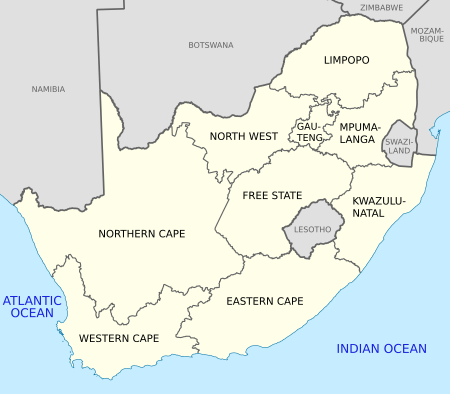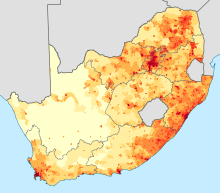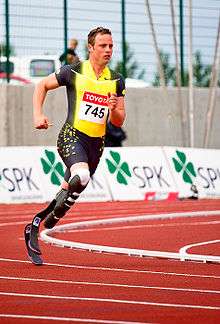Domestic violence in South Africa


Domestic violence in South Africa has been viewed as a private matter until the last few decades. In the 2012 financial year, just over one third of the crimes against women that had been reported were prosecuted in court. Legislation has been passed to help improve the quality of life for those being abused and to prevent further abuse. Although the movement against domestic violence is a new movement, only around since the 1990s, it is making great strides in the country.[1]
Domestic violence
The South African Domestic Violence Act 1998 defines domestic violence as:[2]
Physical abuse; sexual abuse; emotional, verbal and psychological abuse; economic abuse; intimidation; harassment; stalking; damage to property; entry into the complainant's residence without consent, where the parties do not share the same residence; or any other controlling or abusive behavior towards a complainant, where such conduct harms, or may cause imminent harm to, the safety, health or wellbeing of the complainant.[3]
Background
The South African Medical Council released a study in 1998 saying that out of the 1,394 men interviewed, 50% physically abused their female partners at their homes.[4] Considering how recently domestic violence has come to light, it is still considered an early movement. The United Nations found that violence against women was a universal problem.[5] Another study done in 2010 found that a majority of men and over half of women that were surveyed believed that women should obey their husbands.[6][7] It is not uncommon for the abuse to start taking place while the girls are still adolescents.[8] It is also not uncommon for women to tolerate the abuse they are taking because it is such a common practice in South Africa.[9]
Prevalence
In a study done by the World Health Organization, it was found that 60,000 women and children are victims of domestic violence in South Africa.[6] It is hard to gather accurate statistical data in South Africa because domestic violence is rarely reported. On average, in a cross-sectional study conducted in 2002, the women who were abused came from a lower secondary education and were unemployed.[4] The same study indicated that 9.5 percent of women reported being abused within the past year (working back from 2002); in some areas of the country it rose to 28.4 percent of women who reported being abused. In 2013, 50 percent of the women surveyed reported that they had suffered emotional and verbal abuse. Of the women who were in violent relationships, 45.9 percent of them reported injury. In the same study it was found that typically the women who do witness and feel the violence come from a rural childhood compared to those raised in an urban area.[4] Although there are many places that do offer help to those suffering from domestic violence, those resources are more available in urban areas. In rural areas it is harder to access proper resources. Nearly half of the female murders that happened in 1999 in South Africa resulted from domestic violence. The percentage of women who reported experiencing domestic violence at least once in their lifetime is as high as 59 percent.[5]

In a study conducted in 2002 by R. Jewkes et al. over 97% of the black African women who were interviewed had experienced physical violence at some point.[4] In that study out of that 97% who had ever experienced physical violence, over 95% had experienced physical violence within the past year. The women in this study were from the province of Eastern Cape, Mpumalanga, and Northern Province with a mean age of 32.
Rape and sexually transmitted diseases
In 2012 South Africa was called the "rape capital of the world" when less than 1% of rapes that occur are reported to the police.[1] The South African Medical Research Council did an electronic anonymous survey, interviewing just over 1,700 men, that found that one in four males had raped; 73% of those men surveyed had raped before the age of 20.[10] Within rural South Africa there is a higher rate of HIV between partners. In Limpopo, a team of researches traveled to rural villages to implement a three-part trial to test if intervention within relationships that had domestic violence and/ or HIV prevalence in the home.[11] The homes where the researchers just assisted with the problems of domestic violence were able to reduce the prevalence by 55%, but did not effect those who had unprotected sexual intercourse with a non-spousal partner. Although the rate of domestic violence within these small villages did get reduced; the rate of those having unprotected intercourse after being exposed, and diagnosed with HIV, did not go down. According to reports by the U.N., South Africa has one of the highest rates of HIV/AIDS in the world.[12]
Legal actions
Until South Africa established the first democratic society that the country had seen, a law to define domestic violence or protect those who are victims of domestic violence had never been written.[13] Within South Africa, the 1996 Constitution says in section 12c that: "Everyone has the right to freedom and security of person, that includes the right to be free from violence from either public and private sources." The constitution also takes time to highlight that South Africa is based on "non-sexism" values.
Many successful policies have been put in place to help, mostly women, find help escape or refuge from the violence. Human rights throughout the world have viewed sexual violence as a negative situation. After the United Nations held multiple human rights conventions (including the World Conference on Human Rights (1993), International Conference on Population and Development (1994), and the Fourth World Conference on Women (1995) the global agenda for violence against women changed.[14] The advocacy group Soul City broadcast a show on TV and on the radio in 1995 that highlighted the issues associated with domestic violence. Soul City, along with the National Network on Violence against Women, set up a 24-hour crisis line to help women who could be struggling with domestic violence.[13]
Domestic Violence Act
In 1998, South Africa created the Domestic Violence Act to try and protect those who are being abused or might be forced into a situation that could become harmful in the future. At this time, the biggest assistance to women came from the Protection Order that derives from the Domestic Violent Act. The Order allows the courts to stop an abuser from continuing abuse. The collaboration process between representatives of the Department of Justice, Safety and Security, Health Education, Welfare, Correctional Services and the National Directorate for Public Prosecution was a delaying factor that slowed down the process of changing the policies. Within the first year of the Domestic Violence Act being created, 1,696 applications were submitted for protective orders.[15] In a report done by the United Nations Division of the Advancement of Women they found that on the protective orders that women were able to fill out, the forms were only available in two out of the eleven languages that are spoken in South Africa.[15] Other reforms that were created were to sentence mandatory minimal time for specific types of rape under the Criminal Law Amendment Act 1997.[16]

Notable cases of domestic violence in South Africa
Oscar Pistorius
Oscar Pistorius was accused and charged with killing his girlfriend on February 14, 2013.[17] The "Blade Runner", as he is known, shot 30-year-old model Reeva Steenkamp through the bathroom door of their home with a 9mm pistol he said he kept under his bed.[18] Oscar Pistorius, who was 27 at the time of the shooting, stated that he believed it was an intruder in the bathroom, and not his girlfriend, after hearing the sound of the window being opened.[19] The couple had been together since 2012 after attending an award show together. Pistorius previous girlfriend, model Samantha Taylor, was put on the stand during the trial to testify about Pistorius gun use prior to the February 14 shooting.[20] In Taylor's statement she described Pistorius always having his gun with him, even when visiting friends, and frequently waking up in the night fearful of having heard intruders.The prosecutors also believe that Pistorius had shot Steenkamp because of arguments they had had earlier that day.[18]
Charlize Theron
Actress Charlize Theron grew up in a home where she witnessed such abuse. She is known for starring in various movies such as the Italian Job, Snow White and the Huntsman, and Hancock. Theron grew up outside Johannesburg, South Africa with her mother and father. Theron's father was an alcoholic and threatened her and her mother one night. During that incident Theron's mother shot and killed the father, but was not charged because it was ruled as self-defense.[21]
See also
References
- 1 2 SABC. "SABC News - South Africa, worlds rape capital: Interpol :Thursday 19 April 2012". Sabc.co.za. Retrieved 16 January 2015.
- ↑ "Nicky Hartery" (PDF). Justice.gov.za. Retrieved 2016-04-14.
- ↑ Bendall, Charlotte. "The Domestic Violence Epidemic in South Africa: Legal and Practical Remedies." Women's Studies 39 (2010): 100–18. Print.
- 1 2 3 4 Jewkes, Rachel, Jonathan Levin, and Loveday Penn-Kekana. "Risk factors for Domestic violence: findings from a South African cross-sectional study." Social Science & Medicine 55 (2002): 1603–17. Print.
- 1 2 "Violence against women" (PDF). Unstats.un.org. Retrieved 16 January 2015.
- 1 2 "Will the Pistorius Case Change South Africa?". The New Yorker. 16 February 2013. Retrieved 16 January 2015.
- ↑ Breetzke, G.D. "Understanding the magnitude and extent of crime in post-apartheid South Africa." Social Identities 18.3 (2012): 299–315. Print.
- ↑ Wood, K., Maforah, F., & Jewkes, R. (1998). 'He forced me to love him': putting violence on the adolescent sexual health agenda. Social Science and Medicine, 47, 233–242.
- ↑ Wood, K., Jewkes, R. (2001). 'Dangerous' love: reflections on violence among Xhosa township youth. In R. Morrell (Ed.). Changing men in Southern Africa. University of Natal Press: Pietermaritzburgand Zed Books Ltd, London.
- ↑ "BBC NEWS - Africa - South African rape survey shock". News.bbc.co.uk. Retrieved 16 January 2015.
- ↑ "EBSCO Publishing Service Selection Page". Web.b.ebscohost.com. Retrieved 16 January 2015.
- ↑ UNAIDS. (2009) AIDS Epidemic Update. Joint United Nations Programme on HIV/AIDS (UNAIDS). Geneva, Switzerland 2009: 1–50.
- 1 2 Usdin, Shereen, et al. "The Value of Advocacy in Promoting Social Change: Implementing the New Domestic Violence Act in South Africa." Reproductive Health Matters 8.16 (2000): 55-67. Print.
- ↑ Carrillo, R. "Overview of inter nation human rights standards and other Agreements and responses of judicial system to violence against women.” International Journal of Gynecology and Obstetrics 78 (2002): 15-20. Print.
- 1 2 Vetten, Lisa (28 April 2014). ""Addressing domestic violence in South Africa: Reflections on strategy and practice."" (PDF). Un.org. Retrieved 16 January 2015.
- ↑ Bendall, Charlotte. "The Domestic Violence Epidemic in South Africa: Legal and Practical Remedies." Women's Studies 39 (2010): 100-18. Print
- ↑ "Oscar Pistorius Arrested, Facing Murder Charges In Shooting Of Girlfriend Reeva Steenkamp". The Huffington Post. Retrieved 16 January 2015.
- 1 2 "BBC News - Oscar Pistorius trial: Evidence". BBC News. Retrieved 16 January 2015.
- ↑ ABC News. "Oscar Pistorius' Timeline of How He Shot Reeva Steenkamp". ABC News Blogs. Retrieved 16 January 2015.
- ↑ "BBC News - Pistorius fired gun from car, ex-girlfriend tells trial". BBC News. Retrieved 16 January 2015.
- ↑ "Charlize Theron". BiographyChannel.co.uk. Archived from the original on 8 December 2009. Retrieved 30 November 2011.